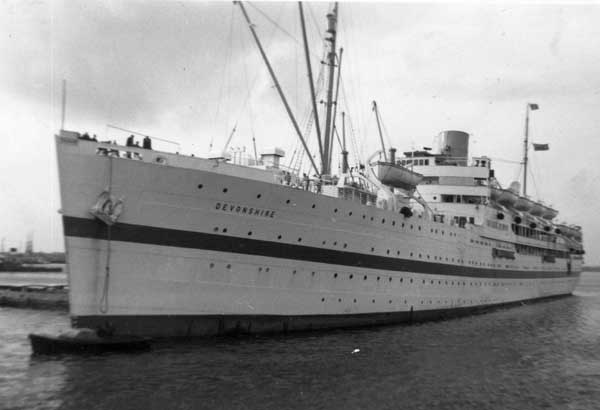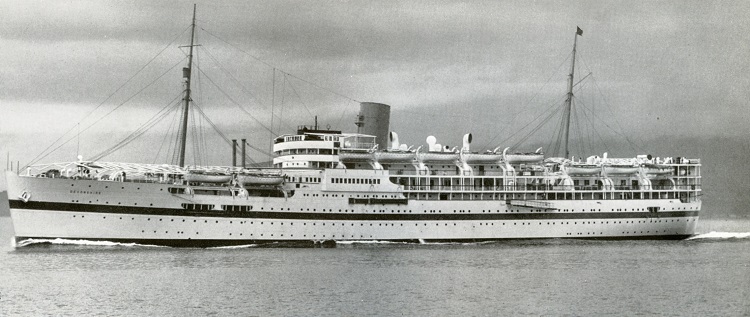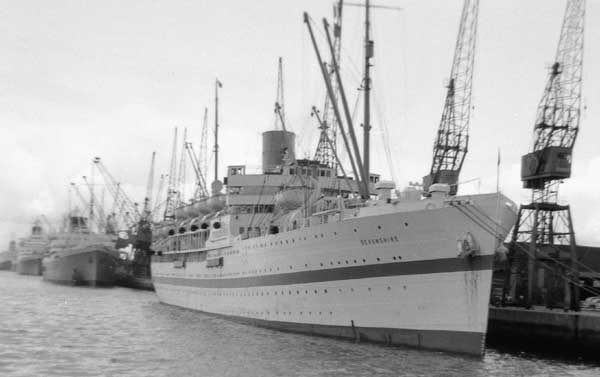
The Devonshire was built for the Bibby Line, Liverpool by the Fairfield Shipbuilding & Engineering Co. Yard at Govan in 1938/39, being launched on December 20th 1938 and completed during July 1939 as a purpose-built troopship, to carry 104 1st Class, 90 2nd Class passengers and 1,150 troops. The Devonshire was a near sister to the British India Company's Dunera.
After delivery the Devonshire reached Dartmouth on July 8th to await her first troopship sailing. On August 11th (or 17th?) 1939 the Devonshire sailed from Southampton for India and would spend the next four-and-a-half years on troopship duties before returning to the United Kingdom. Her trooping voyages took her to the Far East, Australia, South Africa and the Mediterranean.
The Devonshire reached Gibraltar on September 6th 1939, passed through the Suez canal and reached Bombay on September 24th. The Devonshire departed Bombay on October 11th and returned to Gibraltar by October 27th 1939. She would spend the next six months in the Mediterranean, shuttling between Gibraltar, Marseilles and Malta, Alexandria & Haifa. On May 20th 1940 the Devonshire departed Gibraltar for Atlantic & Indian Ocean ports reaching Durban on June 18th 1940 and across the Indian Ocean to Bombay by August 1st 1940. From Bombay two roundtrips were made (Suez & Port Sudan), returning to Bombay by October 20th 1940. From Bombay a roundtrip to Singapore was completed, then remaining at Bombay from November 20th 1940 until January 5th 1941.
The Devonshire sailed from Bombay on January 5th 1941 reaching Haifa on January 30th 1941, then returning to Bombay by February 28th 1941. During March & April visits were made to Penang, Singapore & Madras. By April 25th 1941 the Devonshire was back at Bombay. Then followed several sailings to Basra, Karachi & Massawa and Suez (August 27th 1941). Between September 25th & December 9th 1941 four roundtrips took place between Bombay & Basra.
Two trips to Singapore took place, departing Bombay on December 21st 1941 & January 23rd 1942, arriving Singapore January 3rd 1942 & February 4th, 1942. The second trip coincided with the imminent fall of Singapore, the Devonshire requiring repairs upon her return to Bombay on February 18th 1942.
After the repairs at Bombay the Devonshire visited Basra, Karachi, Colombo, Aden, Suez, Massawa, returning to Bombay by June 22nd 1942. Three days later the Devonshire sailed for Sydney, arriving August 12th 1942. Eleven days were spent at Sydney, prior to the long trip to Suez, reached on October 8th 1942. The remainder of 1942 was spent visiting Indian Ocean ports, with Christmas & the New Year spent at Durban.
The Devonshire sailed from Durban on January 9th 1943 for a further four months operating in the Indian Ocean including visits to Beira, Kilindini, Suez, Aden & Bombay - arriving April 26th 1943. After two weeks at Bombay the Devonshire sailed on May 8th 1943 for Aden (May 16th) and Suez (May 21st). Seven weeks were spent at Suez, being equipped here with landing craft as a Landing Ship Infantry (L). It would later act as the Command Operations Ship during the invasion of Sicily and as an assault ship at the Salerno landings. She then entered the Mediterranean for the first time in three years. The Devonshire would be part of Operation Husky, the Allied invasion of Sicily between July 10th & July 16th 1943, using Convoy MWF36 between Port Said & Sicily. The Devonshire also took part in Operation Baytown (Avalanche), the Allied landings at Salerno between September 9th & September 13th 1943. On November 8th 1943 the Devonshire departed Taranto for Bombay, arriving there on November 27th 1943. The Devonshire was back in Taranto by February 22nd 1944.
The month of March 1944 was spent in the Mediterranean, however the ship departed Port Said on April 8th 1944 headed for Liverpool, arriving there on April 21st 1944. Three weeks were spent at Liverpool, then two weeks at Methil before sailing from Tilbury on June 6th 1944 to Juno Beach, Normandy, returning to the Solent (7th), then to Seine Bay (8th) and again on 30th (from Southend). During the D-Day landings she joined the Bibby Line vessels Worcestershire, Cheshire and Lancashire. The Devonshire was back at Liverpool by September 6th 1944. The Devonshire departed from the Clyde on October 20th 1944, sailing via Suez to reach Bombay on November 29th 1944.
The remainder of 1944 and all of 1945 were spent either servicing ports in the Red Sea, Indian Ocean and as far east as Singapore. Ports not previously visited included Madras, Kyaukpyu, Rangoon, Chittagong & Port Swettenham. VJ Day saw the Devonshire in the Rangoon area. The invasion of Malaya - 'Operation Zipper' - between September 9th & September 19th 1945 involved the Devonshire. During the last quarter of 1945 the Devonshire was shuttling between Rangoon, Singapore & Colombo. On December 23rd the Devonshire departed Colombo for Aden.
June 15th 1946: The Grand Mufti of Jerusalem, who had recently escaped from France, was not aboard the British troopship Devonshire, which was searched before entering the Suez Canal during the week-end. General belief in Port Said that the Mufti had been found was encouraged by the British authorities' silence. The Devonshire was searched three times by the destroyer Virago's boarding party. The Devonshire remained in international waters pending the search by the boarding party. When the ship finally entered port all the crew and troops were wearing life jackets, there was a strong security presence on the dockside and no one was allowed to disembark.
July 1947: Singapore - since April, 22,000 Japanese have been repatriated from South East Asia, mostly utilising Japanese ships manned by Japanese crews. However some British troopships were used when convenient, during July the Devonshire embarked 1,000 surrendered personnel.

March 8th 1948: Singapore - Nine Malay repatriates from Sydney, Australia reached here from Kure (Japan) and landed without incident. They had been transhipped from the Australian troopship Westralia to the British troopship Devonshire at Kure. Two said that they would bring their families to Singapore. Two others said they would seek permission to return to Australia. One hoped to migrate to New Zealand, and one planned to get a job on a ship on the Australia run.
August 21st 1949: Fresh reinforcements for Hong Kong's garrison arrived on the troopship Devonshire. More than 20,000 of the troops due by the end of September had now arrived.
June 15th 1950: Seven hundred Royal Marine commandos arrived at Singapore from Hong Kong in the troopship Devonshire, destined for Penang, where they were to disembark for training camps in Kedah.
September 8th 1950: Singapore - a total of 140 Marine Commandos disembarked from the troopship Devonshire, for onward movement to Korea by air.
In February 1951, en route to Gibraltar and in a gale in the Bay of Biscay, her engines were put out of action when a spare piston rod broke loose. She broached to and rolled to 45% before power was restored.
June 6th 1951: 500 paratroopers of the 33rd Airborne Light Anti-Tank Regiment, Royal Artillery, embarked in the troopship Devonshire at Liverpool for Cyprus. The men were alerted suddenly three weeks previously to prepare for overseas service following the breakdown of the Anglo-Persian oil talks. They arrived in Nicosia on June 21st 1951.
August 1st 1951: the Devonshire sailed from Britain for the Far East. The ship appears to have been delayed in the area of Suez due to an increase in tensions. Troops travelling included the Twelfth Royal Lancers to Singapore to relieve the 4th Hussars, who had been operating against terrorists in North Malaya. Secondly the Royal Northumberland Fusiliers battalion headed for the Korean theatre by way of Port Said, Aden, Singapore, Hong Kong, Pusan and finally Kure, Japan.
December 1951: Wellingtom December 20th — Reinforcements for the New Zealand Korea force, consisting of seven officers and 133 men will sail from Wellington on December 31st. In Sydney they will join Australian troops sailing for Japan in the British troopship Devonshire.
December 28th 1951: Nairobi, The Third Battalion of the King's African Rifles left Nairobi on their way to Malaya. They will embark at Mombasa in the troopship Devonshire, and will be joined later by the First Nyasaland Battalion.
January 21st 1952: Singapore, more than 1,500 trained jungle fighters in the 1st Nyasaland and 3rd Kenya Battalions of the King's African Rifles arrived in the troopship Devonshire to fight Communist guerrillas in Malaya.
February 25th 1952: it was announced that Australia's occupation force in Japan were being sent home. The first draft were set to reach Sydney on Monday (25th) in the British troopship Devonshire. An Army headquarters spokesman said today that the rest would return as shipping became available. Only men for the integrated British Commonwealth Korea force base would remain in Japan. The Devonshire, on loan from the British Government, was carrying 240 soldiers and 56 Army families. The next ship repatriating Australian soldiers and families was expected late in March. It was expected to take several months before all the 2,500 occupation troops in Japan were brought home.
February 28th 1952: Soldiers were called in to load cargo on board the troopship Devonshire at Circular Quay, Sydney after waterside workers had gone on strike. Every ship in the port of Sydney was thrown idle early on February 29th when water side workers staged a mass walk-off from at least 60 ships in protest against the suspension of men earlier this week for having refused to handle three bags of fertiliser to a hand truck, while loading the Interstate freighter Bungaree. The men had insisted that only two bags should be carried on each truck. The Devonshire was expected to sail on Monday March 3rd with Australian troops for Korea. She had arrived at Sydney on February 25th from Japan.
March 3rd 1952: Army security officers thoroughly searched the troopship Devonshire before nearly 1,600 soldiers embarked for Korea. Intelligence officers and bomb experts of the RAE helped in the search. Ship's engineers helped them examine the engine room. 'We feared that Communists might try to sabotage the Devonshire,' an Army officer said. Members of the 1st Battalion Royal Australian' Regiment were given a tumultuous farewell by tens of thousands of people who lined three miles of Sydney streets on a wet March 9th (?) as they marched through the city before embarking on the troopship at Circular Quay. They were bound for Korea. The Devonshire reached Kure on March 18th (also reported March 28th). To the tune of 'Waltzing Matilda' played by the band of the British cruiser HMS Ceylon, the Anzac fighting team marched ashore.
December 18th 1952: Hurricane force winds swept the Hebrides, and gales lashed the western coast of Britain. A gust of wind reaching 105 m.p.h. was reported at Speke, near Liverpool. The gales were accompanied by snow and sleet. Lifeboats stood by at exposed points along Britain's coast. At Stornoway, in North West Scotland, a lifeboat was called to help the 276 ton British trawler, William Cale, in distress in heavy seas. Another British trawler, the Red Lancer, was standing by trying to get a line aboard. The gale delayed the bething of the troopship Devonshire with soldiers from Korea aboard. The troopship, due to have berthed at Liverpool on 18th, was riding out the gale outside Liverpool docks. The 53,000 ton liner United States, holder of the Atlantic Blue Riband, was thrown by a heavy gale against the quayside at Southampton today. Passengers on deck ran for shelter and people on the wharf beat a hasty retreat when it was seen that the giant ship would hit. One lifeboat was wrecked and paint was scraped from the liner's sides. Extra tugs fought a losing battle with the wind to get the liner out of the harbor for the start of its voyage to New York. Finally, it was tied up to wait for better weather.
May 7th(?) 1952: Devonshire arrived at Sydney from Japan.
September 20th (?) 1952: Devonshire arrived in the United Kingdom from Australia (?).
In April 1953 the Devonshire was refitted by her builders, the hammocks were replaced by metal bunks, cafeteria catering was introduced and she was chartered to the Sea Transport Division of the Ministry of Transport to replace the Empire Pride. Her base was transferred from Liverpool to Southampton during 1957. Accommodation was changed to carry 130 1st Class, 96 2nd Class, 99 3rd Class passengers and 824 troops.
July 30th 1957: British troopships would use the Suez Canal again soon for the first time since the Suez crisis, it was planned that on July 28th, the troopship Empire Fowey, bound for the Far East would enter the canal, whilst two days later the Devonshire would pass through in the opposite direction, bringing troops home from Jordan.
Troop movements by sea finished in 1961 when the Devonshire's contract was bought out by the Ministry of Transort, still with seven years to run.

She was sold to the British India Steam Navigation Company on January 17th 1962 for £175,000, to partner the Dunera as an educational cruise ship. The Devonshire was renamed Devonia and after a refit by Barclay Curle Company at Whiteinch, she could carry 190 1st Class, 96 2nd class and 830 students in dormitories. The Devonia entered this service at Easter, her cruise career took her to most parts of the Mediterranean and the Baltic and would complete 110 educational cruises.
On September 11th 1964 whilst at Greenock the upperworks of the Devonia were fouled by the Swedish ore carrier Tostero. Major superficial repairs were carried out in the newly completed drydock facility at the Firth of Clyde drydock, Inchgreen. Two months were required to make the necessary repairs.
The Devonia sailed on in this capacity until she was sold on December 15th 1967 to Cantieri Navali, Genoa to be broken up. Demolition took place at La Spezia during January 1968.
Details
Built: Fairfield Shipbuilding & Engineering Co., Govan; yard No.670
Launched: December 20th 1938
Tons: 11,275 gross; 6,758 net
Tons: (after April 1953) 12,773 gross; 8,508 net
Length: 516ft 9in
Breadth: 63ft 4in
Draught: 24ft 7in
Propulsion: 2 x 8-cylinder Sulzer, Winterthur diesel engines totalling 6,300bhp.
Screws: 2
Speed: 16 knots
Crew: ??
Resources:
Convoyweb
National Library of Australia : Trove website of archived Australian Newspapers (trove.nla.gov.au)
Page added October 17th 2013.
Last updated June 17th 2020.
Return to Ship menu
Return to site menu